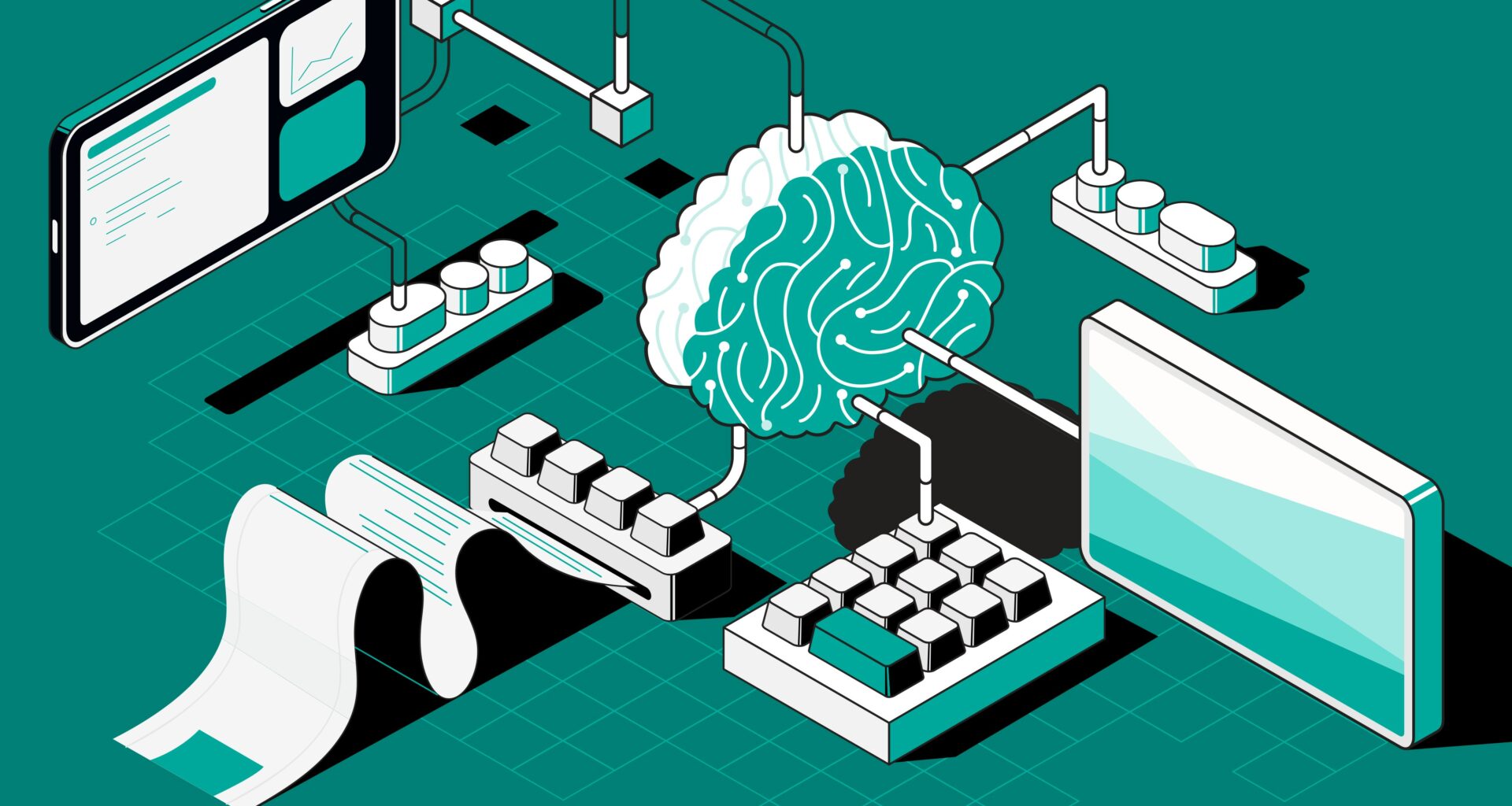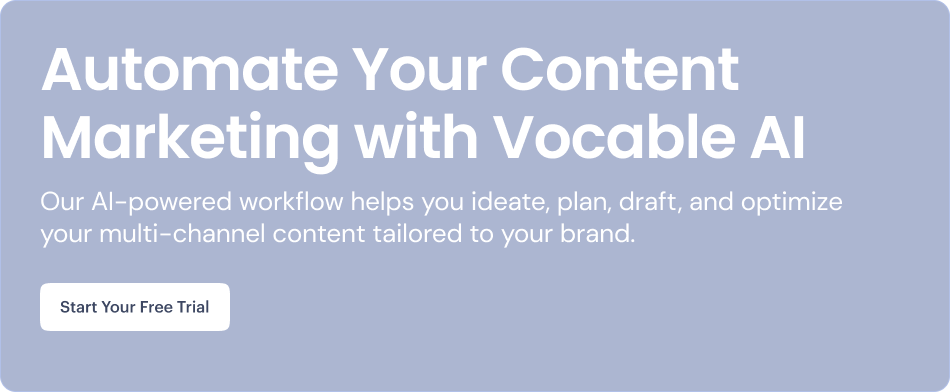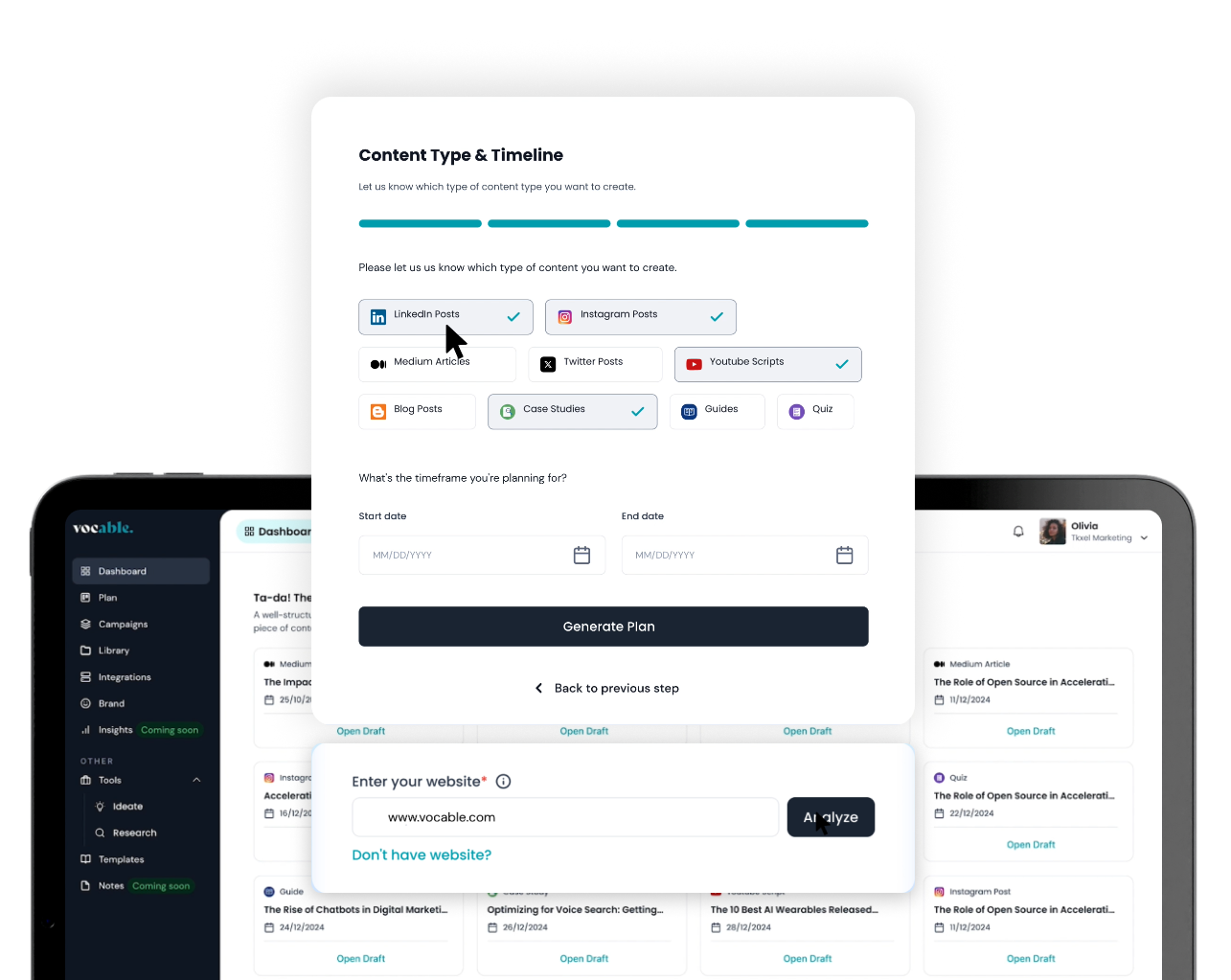Building an AI-Human Hybrid Content Team and Workflows

Iman OubouDecember 19, 2024 4 min read
I started my morning today (like many others) by opening my laptop to review this month’s content generated by our AI tools. Three years ago, this morning ritual didn’t exist. My team would spend their mornings in a cramped meeting room, brainstorming ideas and dividing up writing assignments. Today, my expanded team of 2 human writers and an array of AI tools, including our own Vocable’s AI content platform – produces triple the content while maintaining the authentic voice that makes us a trusted industry authority.
But this new scenario isn’t unique to us. Across the digital landscape, content teams are undergoing a fundamental transformation. The integration of AI tools with human expertise has created a new paradigm in content creation—one that promises greater efficiency without sacrificing the creative spark that drives meaningful engagement. But building and managing such a hybrid team requires more than simply adding AI tools to existing workflows. It demands a complete reimagining of how content teams operate, collaborate, and measure success.
The Evolution of Content Teams
The traditional content team structure—a group of writers, editors, and strategists working in linear progression—served us well for decades. However, the exponential growth in content demands has exposed its limitations. When I first attempted to scale my publishing company SWAAY’s content production in 2017, I followed the conventional wisdom: hire more writers. We quickly realized that simply adding more people to the team wasn’t sustainable. The coordination overhead increased exponentially, and maintaining consistent quality became a nightmare.
That’s when I saw the future of content creation. In 2019, long before ChatGPT entered the scene, I began experimenting with early GenAI models like GPT-2, integrating them with my own content creation process. This experiment evolved into Vocable’s core innovation: an AI-powered content system where AI handles the heavy lifting of research and initial drafts, while human experts focus on strategy, insights, and brand voice alignment.
Through our AI content system and framework, many businesses increased content output while reducing costs and coordination overhead by 60%.
So what is the Anatomy of a Modern Content Team?
Today’s successful hybrid content teams operate more like orchestras than assembly lines. Each component—human and AI—plays a specific role in creating a harmonious final product. At the heart of this new structure lies a fundamental shift in how we view content creation roles:
Content strategists and content managers need to evolve from simply planning editorial calendars to becoming AI-human workflow architects. They must understand both the capabilities and limitations of AI tools while recognizing when human creativity will have the most impact. Our strategists now spend significant time fine-tuning AI parameters and identifying opportunities where human expertise can add the most value.
They need to also identify and implement the right AI tools to simplify and systematize the process of organizing content. These tools can help ensure all assets—ideas, drafts, campaigns, and publishing schedules—are aligned, accessible, and easy to manage. For example, AI can automatically analyze data to suggest optimal posting times, detect gaps in content coverage, and even generate full content plans based on target keywords or campaign goals.
Writers in hybrid teams have transformed from pure content creators to content enhancers and AI coaches. They guide AI tools through sophisticated prompts, enhance AI-generated drafts with unique company insights, and ensure the human element remains present in every piece. Initially, some of our writers feared AI would replace them, now they view AI as their personal research assistant and first-draft generator, allowing them to focus on higher-value activities like adding industry expertise and creative storytelling.
Editors have perhaps undergone the most significant transformation. Beyond checking grammar and style, they now serve as quality arbiters between AI and human-generated content, achieving a seamless integration and maintaining the delicate balance between efficiency and authenticity. They work closely with AI detection tools, SEO guidelines and quality metrics to ensure all content, regardless of its origin, meets the highest standards.
Quick Tips
Framework for Deciding: AI vs. Human
- Use AI for speed and scale, like tasks that are repetitive, data-driven, or require efficiency, like generating ideas, organizing schedules, or creating first drafts. AI thrives in processes where structure and patterns matter.
- Bring humans into the mix for creativity and nuance, like tasks that need emotional intelligence, strategic decision-making, or a personal touch, like crafting stories, defining brand voice, or refining complex ideas. Humans excel where originality and empathy are essential.
Rule of Thumb: Let AI handle the “what” (suggesting, automating, scaling), while humans focus on the “why” and how” (strategizing, personalizing, and elevating).
The AI/Human Process
The success of a hybrid content team depends heavily on establishing clear processes that leverage the strengths of both human and AI contributors. As we are now scaling Vocable’s own content marketing efforts, I implemented a three-phase content development process that can become a model for hybrid teams.
- In the Discovery Phase AI tools analyze market trends, competitor content, and user engagement data to identify content opportunities. Human strategists then evaluate these insights through the lens of brand values and business objectives, selecting topics that align with both data-driven opportunities and strategic goals.
- The Creation Phase begins with AI generating comprehensive content plan and initial drafts through platforms like Vocable.ai which offers advanced content generation capabilities. Human writers then transform these initial drafts into compelling narratives, adding industry expertise, original insights, and creative elements that AI cannot replicate. The key is to view AI-generated content not as a final product, but as a sophisticated first draft. Our writers spend less time on researching, planning, outlining and basic writing, allowing them to focus on adding the layers of expertise and creativity that make content truly valuable.
- The Refinement Phase involves a collaborative effort between AI quality checking tools and human editors. AI systems analyze content for SEO optimization, readability, and engagement potential, while human editors ensure brand voice consistency and add the subtle touches that make content resonate with readers. This dual-layer quality control process has resulted in a 40% increase in content engagement metrics.
How Do You Measure Success in The Hybrid Era
Traditional content metrics—page views, engagement rates, and conversion rates—remain important, but new metrics have emerged to evaluate the effectiveness of hybrid teams. Efficiency metrics now track the time saved through AI assistance, while quality metrics assess the seamless integration of AI and human elements. Cost-per-impact calculations help organizations understand the ROI of their hybrid approach. Here are a few to keep in mind:
1. Efficiency Metrics
What It Measures: Time saved by AI in completing tasks like drafting, scheduling, or analysis.
How to Calculate: Compare time taken for a task with and without AI, then track cumulative savings over a week or month.
2. Quality Metrics
What It Measures: The effectiveness of AI-generated content and its alignment with brand standards.
How to Calculate: Track the percentage of AI-generated drafts requiring minimal edits versus significant revisions. Conduct sentiment analysis to assess audience perception.
3. Cost-per-Impact (CPI)
What It Measures: The financial return on AI integration in workflows.
How to Calculate: Divide the cost of AI tools by measurable outcomes like increased engagement, faster production, or revenue growth.
4. Collaboration Ratio
What It Measures: The balance between AI and human contributions in content creation.
How to Calculate: Track the proportion of content elements generated by AI versus those created or revised by humans.
5. AI Effectiveness
What It Measures: The actionable success of AI recommendations and outputs.
How to Calculate: Monitor the percentage of AI-suggested ideas or formats that are executed and perform well (e.g., high engagement rates or conversions).
6. Revision Time Metrics
What It Measures: How much human effort is needed to finalize AI-generated content.
How to Calculate: Log the time spent revising or enhancing drafts, then compare it to fully human-generated workflows.
Looking Ahead
Perhaps the most surprising insight from organizations that have successfully implemented hybrid teams is that the human element has become more, not less, important. As AI handles routine tasks and initial content generation, human creativity, expertise, and emotional intelligence have become key differentiators in content quality.
As we look to the future of content creation, one thing becomes clear: the success of content teams will depend on their ability to effectively blend AI efficiency with human creativity. Organizations that master this balance, supported by sophisticated platforms, will be best positioned to meet the growing demands for high-quality, engaging content.
The key lies not in viewing AI as a replacement for human creativity, but as a powerful tool that enables human content creators to work at their highest potential. By building and nurturing hybrid teams that leverage the strengths of both AI and human contributors, organizations can create content that is not only more efficient to produce but also more impactful and engaging for their audiences.
For those looking to begin their journey toward building a hybrid content team, the path forward is clear: start with a clear understanding of your content goals, invest in the right tools and training, and maintain a steadfast commitment to quality and creativity. The future of content creation isn’t about choosing between AI and human expertise—it’s about bringing them together in an optimal process.
Get Started with Vocable
Master every aspect of Vocable, from automated content planning to publishing in these step-by-step tutorials and product guides.
Get Started Now





